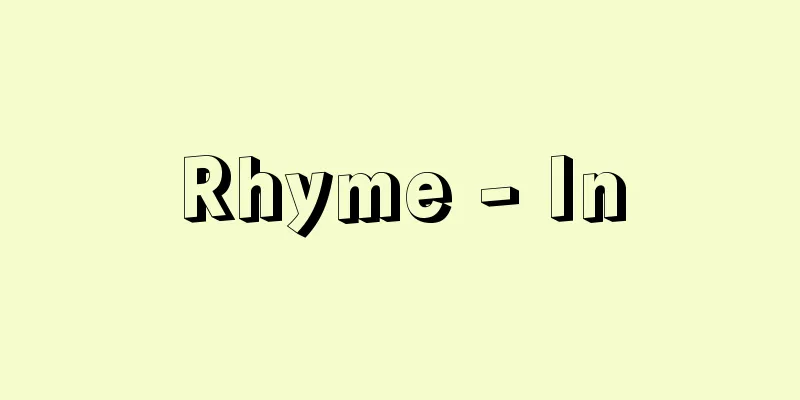Rhyme - In

|
〘Noun〙① The sound of a voice. Tone. ※Sarugaku Dangi (1430) The heart of music "You should pay careful attention to the sound of the character for clouds and the sound of the same. " [Rokusho Ko]② The sound of a Chinese character, the part of the syllable expressed by a single Chinese character excluding the first consonant. Also, a classification of it. Divided into four tones, Hei, Shou, Ki, and Nyu, according to the difference in tone, there were over 200 rhymes in the past, but later they were reorganized and classified into over 100 rhymes. The former are called Koin or Hiroin, and the latter Imain or Hei-suiin. Rhymes belonging to Hei-shou are also called Hei-in, and rhymes belonging to the three tones Shou, Ki, and Nyu are called Sokuin , and they are sometimes divided into two major categories. →Four tones (shisei) and Hyousoku (hyousoku). ※Genji (around 1001-14), Kasamegi: "There are so many difficult characters that even learned scholars are confused in many places." [Nanshi - Rikuju-den] ③ In literary works, especially poetry, the same or similar sounds are repeated at the beginning or end of each line. Also, a sentence using them. ※Sugake Bunso (around 900), 7th Midan Kuifu, 1st poem: "On autumn nights I think about politics , what will make the people happy ? I use rhyme to make it work again and again." ④ = Inji (rhyme characters) ※Haikai - Sansatsusho (1702), Hakusoushi: "The reason why rhyme is called 'staying' is because it is stavenged by characters." ⑤ Mood. ※Gukansho (1220), 3rd "It should be kept as it is, but no one tries to understand this rhyme in a glossy way." [Tao Qian - Return to the Countryside Poem] Source: The Selected Edition of the Japanese Language Dictionary About the Selected Edition of the Japanese Language Dictionary Information |
|
〘名〙① 音声の響き。音色。※申楽談儀(1430)音曲の心根「あなたの云をさめの字のゐんを、能能(よくよく)心えべし」 〔六書故〕② 漢字音で、漢字一字の表わす音節の、最初の子音を除いた部分。また、それを類別したもの。声調の違いによって平・上・去・入の四声に分けられ、古くは二百余韻、のちに整理されて百余韻に類別される。前者を古韻または広韻、後者を今韻または平水韻という。また、平声に属する韻を平韻、上・去・入の三声に属する韻を仄韻(そくいん)と呼んで、二大別することもある。→四声(しせい)・平仄(ひょうそく)。※源氏(1001‐14頃)賢木「難きゐんの文字どもいと多くて、おぼえある博士どもなどの惑ふ所々を」 〔南史‐陸厥伝〕③ 文学作品とくに詩歌で、各句の頭あるいは末に反復して置かれる同一または類似の音。また、それを用いた文章。※菅家文草(900頃)七・未旦求衣賦一首「以二秋夜思レ政、何道済一レ民、為レ韻依レ次用之」④ =いんじ(韻字)※俳諧・三冊子(1702)白双紙「留を韻といふ事、文字にて留るゆへ也」⑤ おもむき。※愚管抄(1220)三「その儘にたがえず心うべきにて有るを、つやつやとこの韻に入りて心得んとする人もなし」 〔陶潜‐帰田園居詩〕
出典 精選版 日本国語大辞典精選版 日本国語大辞典について 情報 |
Recommend
Christian Trade Union Confederation - Christian Trade Union Confederation
...In addition to being divided into Socialist, C...
Hymenolepis diminuta (English spelling) Hymenolepisdiminuta
… [Shomei Kojima]. … *Some of the terminology tha...
Ishikawa Gian
...Rousseau's Confessions proved that an ordi...
Panta rhei (English spelling) pantarhei
…He was from the royal family of Ephesus. He is c...
Daishi lecture - Daishiko
This is an event where offerings of red bean porr...
Overflow diabetes
…For example, in the case of diabetes, it is excr...
Tsugaru Peninsula - Tsugaru Peninsula
A peninsula that juts out north from the western ...
Volcanic gas - Kazan gas (English spelling)
Gas that erupts from volcanoes. It is also called ...
Stylochus frontalis (English spelling)
… [Minoru Imajima]. … *Some of the terminology th...
Swordfish - swordfish (English spelling)
It is a marine fish belonging to the order Percif...
Aluminous cement
...Because it is a fine particle, it has a high p...
Atlanthropus - Atlanthropus (English spelling)
A hominid excavated from North Africa. Three mand...
The World
…In 1978, he bought the St. Louis Dispatch, which...
Ethylenimin
…Ethylenimine is also known as azacyclopropane. I...
Diet - Food
It refers to the habits of animals when they cons...









